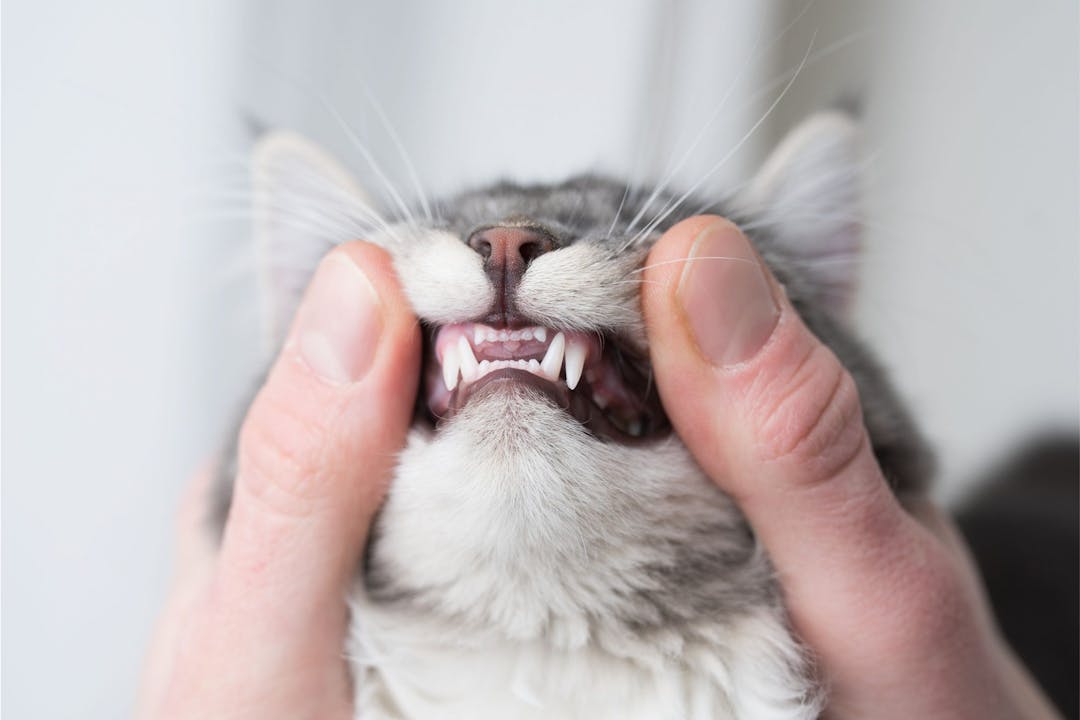Keeping your cat’s teeth healthy is a crucial part of their care. It’s estimated that between 50-90% of cats over the age of 4 suffer from some kind of feline dental disease. However, your cat doesn’t have to endure painful teeth. Dental disease in cats is largely preventable as long as you monitor your cat and take the steps needed to keep their mouth healthy. So, what are the dental issues to look out for and how can you act preventatively? Read on!
Familiarize yourself: gingivitis, periodontitis, tooth resorption
Gingivitis, periodontitis, and tooth resorption are the most common dental diseases in cats. Here is what you need to know:
Gingivitis
If you notice that your cat’s gums are red and swollen or that their breath is bad, it could be gingivitis. While bacteria in your cat’s mouth is actually normal, the plaque build up still needs to be cleaned, just as in humans. That’s because bad bacteria living in the plaque can end up causing discomfort in your cat. When disease-causing bacteria starts to travel below the gumline, gingivitis occurs. It’s thought that there is a connection between gingivitis and kidney disease in cats. The good news is that gingivitis is easily preventable and treatable.
Periodontitis
If gingivitis is left untreated, it can become periodontitis, which is a more serious type of dental disease in cats because it cannot be easily reversed. In the beginning, your cat may exhibit red, swollen gums. You may also notice that your cat’s breath smells really bad. Periodontitis progresses and separates your cat’s teeth from its gums. This process can lead to loose teeth or teeth that fall out completely.
Tooth Resorption
Tooth resorption is the most common cause of tooth loss in cats. Cat parents may notice a pinkish-red discoloration at the base of the tooth; it may look like the gums are severely inflamed. However, because tooth resorption occurs from the inside of the tooth and then spreads outward, by the time this is noticed the tooth has already been badly damaged. This can be really painful for cats and they may stop eating. Sometimes the functionality of the tooth can be restored, but depending on the severity of the resorption, the tooth may need to be removed.
Preventing dental disease in cats: what you should know
Brushing your cat’s teeth
When it comes to dental disease in cats, an ounce of prevention is worth a pound of cure. At Airvet, we recommend brushing your cat’s teeth at least 3 times a week to clean away tartar buildup. You can learn more about brushing your cat’s teeth here. It’s important to note that cats should never be given human toothpaste as it contains fluoride which is dangerous to animals. Be sure to use an enzymatic pet toothpaste, as those are the best at reducing the bacteria at the gumline.
Check your cat’s gums and teeth
Besides regular brushing, you should also check your cat’s gums – but be sure you know what you’re looking for. A healthy cat’s gums are pink, not red; their teeth are white; and their breath should never smell bad. To check on your cat’s teeth, gently lift their upper lip to get a good look. Make sure to give them a (dental) treat afterwards!
Dental cleanings
Lastly, you should schedule annual teeth cleanings with your veterinarian. During this procedure, your cat will be anesthetized. The vet is able to not only deep clean your cat’s teeth but also thoroughly examine your cat’s mouth for any issues that may be hard to detect when not under anesthesia. After the cleaning, your vet may send you home with special cat treats or mouth sprays that break down plaque and keep their breath smelling fresh.
Cat dental care is an oft overlooked aspect of pet ownership. If your cat’s dental health goes unchecked, they can develop dental diseases that can have serious consequences. Checking on your cat’s teeth and gums is very simple and can prevent more expensive vet bills later on. Prevention is the most important aspect of cat dental care, and is easily achieved from your own home! If you have questions or concerns about your cat’s teeth and gums, contact Airvet and instantly connect with a veterinarian. Haven’t downloaded the app yet? What are you waiting for? Download the app now.





